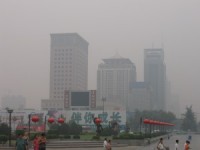By Steve Milloy ——Bio and Archives--January 6, 2012
Global Warming-Energy-Environment | CFP Comments | Reader Friendly | Subscribe | Email Us
 The Chinese city of Xi’an has some of the worst air quality in the world. Yet its air is significantly safer than the air in U.S. cities, according to a new study.
And if you have trouble believing that, then you ought to have trouble believing Obama Environmental Protection Agency claims that U.S. ambient air quality is killing tens, if not hundreds of thousands of people per year.
The Chinese city of Xi’an has some of the worst air quality in the world. Yet its air is significantly safer than the air in U.S. cities, according to a new study.
And if you have trouble believing that, then you ought to have trouble believing Obama Environmental Protection Agency claims that U.S. ambient air quality is killing tens, if not hundreds of thousands of people per year.Particulate matter [i.e., PM2.5] causes premature death. It doesn’t make you sick. It’s directly causal to dying sooner than you should.Leaving the fantasy land of EPA air quality science and returning to the real-world, however, clean U.S. air is axiomatically not more dangerous than filthy Chinese air and so some sort of explanation of these results is required. The scientific and medical reality is that PM2.5 — even as high as it is in China — does not kill or hasten death. PM 2.5 was such a public health problem in the U.S., in fact, that no one knew about it until EPA-funded researchers invented it in 1993 with the so-called “Six Cities Study” — 30 years after the Clean Air Act was enacted. Concern for PM2.5 — the primary and virtually sole justification for recent costly EPA regulation like the Cross-State Air Pollution Rule (CSAPR) and the Mercury and Toxics Standard (MATS) — has been entirely manufactured and ruthlessly exploited by the EPA for almost 20 years. The agency has been able to get away with this scam because it has cleverly hidden key data with a clique of private researchers in academic institutions who are beyond Congressional and Freedom of Information Act reach. Obtaining the EPA data may no longer be so important for debunking purposes, however, given the emerging reality in China.
View Comments
Steve Milloy publishes JunkScience.com and GreenHellBlog.com and is the author of Green Hell: How Environmentalists Plan to Control Your Life and What You Can Do to Stop Them